Since I reviewed my first carbon dioxide monitor, the Aranet4 Home, back in September last year, my conclusion has remained the same. While many carbon dioxide monitors are on the market, the Aranet4 Home has remained the best choice – as long as you don’t mind the hefty price tag.
Some monitors have beaten it in particular aspects. For example, the Vitalight Mini CO₂ Detector is a far more portable device with similar accuracy. On the other hand, the CO₂.Click Model C is a far better option for users who need to manage multiple monitors from one dashboard.
However, none of these monitors rivals the Aranet4 Home in all categories, making the Aranet4 my typical recommendation. It’s well-rounded, does its job, and does it well. Today, however, my usual carbon dioxide monitor recommendation might change a bit as I can finally present my review of a device that offers many of the same strengths as the Aranet4 Home but at a more affordable price.
In today’s article, I will be reviewing the INKBIRD IAM-T1. This monitor has just been released and joins INKBIRD’s extensive line of connected environmental monitors. With such a strong line of monitors, I expected a lot from the IAM-T1. Let’s see if the INKBIRD carbon dioxide monitor matches my hopes and expectations.
It’s evident at first glance that this device has taken a lot of inspiration from the SAF Tehnika device, and it’s clearly the direct competition to this new INKBIRD device. As such, I will be making a lot of comparisons to the Aranet4 in this review article.
If you’re interested in how the INKBIRD IAM-T1 stacks up against other carbon dioxide monitors, please refer to this article on the best carbon dioxide monitors. In this article, I compare the pricing, specifications, and sensors of various consumer-grade CO₂ monitors to help you select the best monitor for your needs.
On the other hand, if you’re just interested in learning why I believe the INKBIRD IAM-T1 is such a well-rounded carbon dioxide monitor, read on!
Subscribe to BreatheSafeAir
Air pollution is a silent killer that affects millions of people worldwide. Start protecting yourself today.
This post contains affiliate links. For more information, please refer to my affiliate disclaimer. I was sent a product for review, but the article is not sponsored. All opinions expressed in this post are my honest thoughts. I only recommend products that I genuinely believe in.
Information on this blog is for informational purposes only. Readers are encouraged to confirm the information herein with other sources. Furthermore, this information is not intended to replace medical advice from professionals. This website assumes no responsibility for the accuracy of the information, and information is subject to change without notice. Devices mentioned on this website are not medical devices and do not guarantee protection.
Sensors & Accuracy

The INKBIRD IAM-T1 features four sensors. The first and most important of these, the CO₂ sensor, is from Senseair, a Swedish-based company at the forefront of NDIR technology and research. Most consumer-level carbon dioxide monitors will use either a sensor from Senseair or Sensirion, meaning that the accuracy you can expect from this device should be in line with other devices, such as the Aranet4 Home, which is proven to be quite accurate.
The other three sensors (temperature, relative humidity, and atmospheric pressure) are found on a chip from Sensirion. This is another well-established and trusted company in the environmental monitoring space.
The IAM-T1 uses an NDIR (non-dispersive infrared) sensor, the gold standard for monitoring CO₂. You should always look for an NDIR sensor in any device you are considering, and the INKBIRD IAM-T1 uses one of these sensors. The stated accuracy of the sensor is 3% ± 30 ppm up to 5000 ppm. Above 5000 ppm, accuracy drops significantly (to 10% of the reading) as the results need to be extrapolated from the sensor’s calibrated range. However, this is not an issue, as you shouldn’t be seeing readings above 5000 ppm regularly, if at all.
The accuracy of the temperature, relative humidity, and atmospheric pressure sensors can be found in the table below. While these sensors take second place in importance to the CO₂ sensor, they are handy to have and provide a more well-rounded air quality monitoring experience.
| Sensor Performance | Range | Resolution | Accuracy |
|---|---|---|---|
| CO₂ Concentration | 0 – 9999 ppm | 1 ppm | 3% ± 30 ppm (up to 5000 ppm) 10% of reading (above 5000 ppm) |
| Temperature | 0 – 50 °C | 0.1 °C (0.1 °F) | ± 0.3 °C (± 0.5 °F) |
| Relative Humidity | 0 – 85 % | 1% | ± 3% |
| Atmospheric Pressure | 600 – 1100 hPa | 1 hPa | -2 hPa/ +3 hPa |
While I trust these claims as I have a lot of experience with Senseair sensors, I also wanted to run my own test to see how the INKBIRD IAM-T1 compares to other popular carbon dioxide monitors when measuring the CO₂ concentration. It’s essential not to take manufacturers at face value, and I wanted to see how the device performed myself.
To test the accuracy of the carbon dioxide sensor within the INKBIRD IAM-T1, I ran an experiment comparing the measurements to other competing products on the market. While this comparison isn’t scientific, I placed the monitors in a ventilated box with an ingress and egress fan. This ensures a constant flow of air and removes potential eddies of carbon dioxide. The monitors were placed with their sensors at approximately the same height, as carbon dioxide is heavier than air and will fall over time, leading to higher readings closer to the ground.
I compared the readings of the four devices (The IAM-T1, Aranet4 Home, CO₂.Click Model C and Vitalight Mini CO₂ Detector) over two hours, taking a reading every five minutes. I synced the devices (and used the manual reading mode on the Aranet4) to ensure the devices took readings simultaneously. The box was placed in my office as I worked, so these readings represent an actual situation to which they will likely be regularly exposed. Below are my results:

Before discussing the results, there are a few things to note here. All devices were manually recalibrated an hour before I ran this test; however, not all have the same baseline value. Some devices calibrate to 400 ppm, whereas others calibrate to 420 ppm. As such, there will always be a difference between the devices, even if they’re otherwise reading accurately. Furthermore, these devices have a stated accuracy of 3% ± 30 ppm or 5% ± 50 ppm, meaning some deviation in results is expected.
The blue line represents the INKBIRD IAM-T1, and from my experience, this device tends to read a bit higher than the Aranet4 Home but very similarly to the Vitalight Mini CO₂ Detector. Interestingly, in my Vitalight Mini CO₂ Detector review, I found it recorded very similar results to the Aranet4, often giving the exact same readings. As such, I consider both devices accurate, and the difference is within the accuracy specifications of all devices. I believe the differences here are partly due to the different baseline values and subtle differences during the calibration process.
Importantly, all devices show the same trend and record within about 50 ppm of each other both at the low end and high end of the graph. While there are differences in individual readings (and we can see some devices tend to read higher and others lower), all of these devices are accurate and can provide valuable insights into local carbon dioxide concentrations.
Variation between devices tends to increase as carbon dioxide concentration increases, and the devices would likely differ a hundred parts per million or more at high concentrations. However, while the accuracy of no device is perfect, they all are quite accurate. At the end of the day, if a device reads 2100 ppm or 2200 ppm, your actions should remain the same (increase ventilation, or if used as a proxy for airborne illnesses, mask up!).

I reran the test at a higher CO₂ concentration to confirm my findings. The concentrations in this test are still reasonable (1400 ppm – 1750 ppm) and are concentrations we regularly encounter daily. At these concentrations, we see the same trends as in the previous graph and, perhaps surprisingly, the deviation between the monitors stays approximately the same. Again, I would attribute these minor differences in results to the different baseline values and variance within the stated accuracy.
Before moving on, one final point needs to be addressed here: calibration. NDIR sensors can drift over time, and if not calibrated, they will gradually become less accurate. This can be avoided by regularly exposing the sensor to ambient air and calibrating the device. With this measurement, the device will set a new baseline to compare future readings.
Many carbon dioxide monitors have manual calibration, allowing users to choose when this process happens. This is ideal, and the IAM-T1 supports manual calibration through the app. However, there are also devices that either use or rely on automatic calibrations. Automatic calibrations allow the device to calibrate itself automatically to the lowest concentration it’s exposed to every set period – in this case, every eight days.
The IAM-T1 allows users to toggle between automatic and manual calibration. However, I always caution against automatic calibration as the device can begin reading inaccurately if it isn’t exposed to fresh air at least once a week. This isn’t an issue if you’re taking the device outside or leaving it in a room without people regularly, but it can become an issue if it’s always used in a bedroom or even in a lounge that constantly has people or animals in it (I’ve encountered the latter issue as the dogs sleeping in my lounge prevented the CO₂ concentration from ever dropping to ambient levels!).
It’s worth noting that this sensor doesn’t maintain its accuracy as well as the Sunrise sensor found in the Aranet4 Home and Aranet4 Pro. While this shouldn’t be an issue if the device is regularly calibrated, as both sensors have similar stated accuracies, you will want to ensure you calibrate it every few months.
Purchase IAM-T1 from Amazon | INKBIRD
Display & Build Quality

At first glance, the INKBIRD IAM-T1 is a simple device. This doesn’t change after seeing the device in person – it’s a plain device with little that stands out. However, upon closer inspection, a few details become apparent.
The IAM-T1 is a small cuboid with dimensions 75x80x30mm. While small, it’s not tiny and isn’t always pocketable (more on that in the portability section). It’s a bit bigger than the Aranet4 Home and significantly larger than the taller CO₂.Click Model C.
For its size, the IAM-T1 is surprisingly heavy and has a heft to it that makes it feel high-quality. While the device is entirely plastic, with the exception of a piece of fabric on the front, it does not feel cheap and instead feels well-built and ready to be placed in a pocket or backpack.
The front of the device is minimal, with a rectangular E-ink screen sitting above a slice of fabric sporting the ‘INKBIRD’ logo. Turning the device around, you will see large vents on both the left and right sides of the device. Finally, on the back, you will find a mounting hole for the monitor mounted to the wall.

Interestingly, the whole backplate of the IAM-T1 pops off, similar to an older smartphone with a user-replaceable battery. Under this cover, you will find two double A battery slots, a button that swaps between Celsius and Fahrenheit readings, and a Bluetooth switch. It’s very simple, but most of the essentials are here. The one button or switch I want to see added is a manual calibration switch, which can only be performed on the app. Since the device also features auto-calibration (if you enable it), it would also be handy to see a mode switch on the back of the device.
Turning the device around, you will find a nice-looking E-ink screen with fantastic viewing angles. If you choose to mount this device on a wall or desk, you will find it easy to view – even if you’re viewing the screen from an extreme angle.
The screen is not backlit, so you won’t be able to read it in the dark. However, since the device is connected, you can easily check the CO₂ concentration at nighttime through the app. If you want to check the device itself, you will need an external light.
INKBIRD’s UI is minimal, and the screen displays the current CO₂ measurement in parts per million with large text. To the right of this reading, you will find the current temperature (in either Celsius or Fahrenheit) and the relative humidity. Interestingly, although the device also measures atmospheric pressure, this is only visible from within the app – again, similar to the Aranet4 Home.
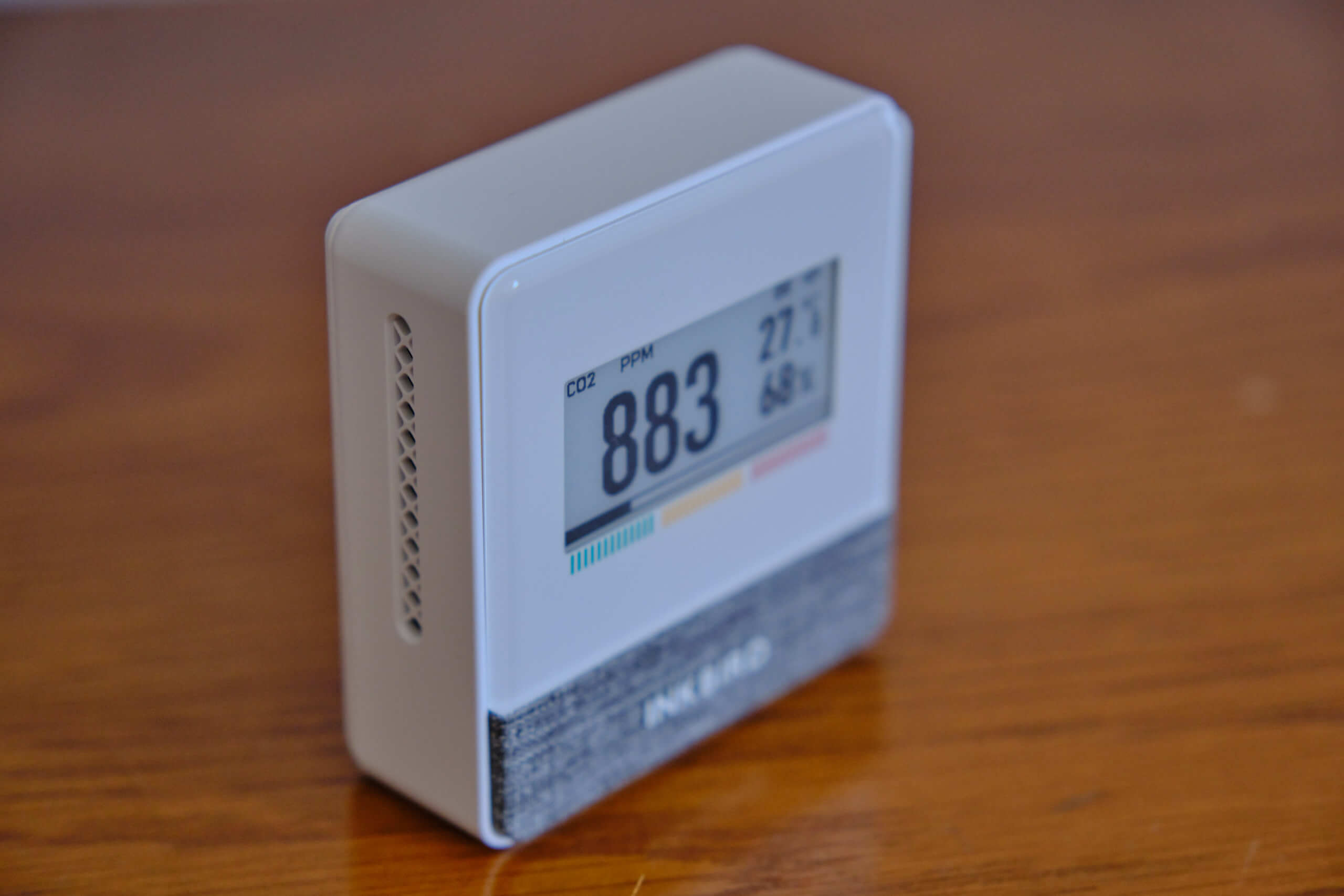
You will also find three small icons on the top right. These icons show the current Bluetooth status (enabled or disabled), whether the device has sound or is muted, and whether auto-calibration is enabled. The speaker can be set to notify you the first time the device reads a specific CO₂ concentration (which can be set by the user) or every time the concentration exceeds the set value.
Finally, at the bottom of the screen is a bar. Underneath this bar are three coloured sections, green, yellow, and red, just like a traffic light! As the CO₂ concentration increases, the on-screen bar will fill up and move from green to yellow to red to represent higher carbon dioxide concentrations.
While the Aranet4 Home has a similar function via the three coloured icons on the bottom of the screen, I prefer the INKBIRD approach as the bar makes it easier to explain to others unaware of how carbon dioxide concentrations impact us. Even better, this bar can be customised with user-set values via the app.
Overall, I like the design of the INKBIRD IAM-T1, and there are no major downsides here. The only potential downside is the relatively large size compared to some other carbon dioxide monitors on the market. Let’s discuss that in more detail in the portability section to see if it’s a deal-breaker for you.
Purchase IAM-T1 from Amazon | INKBIRD
Portability & Battery
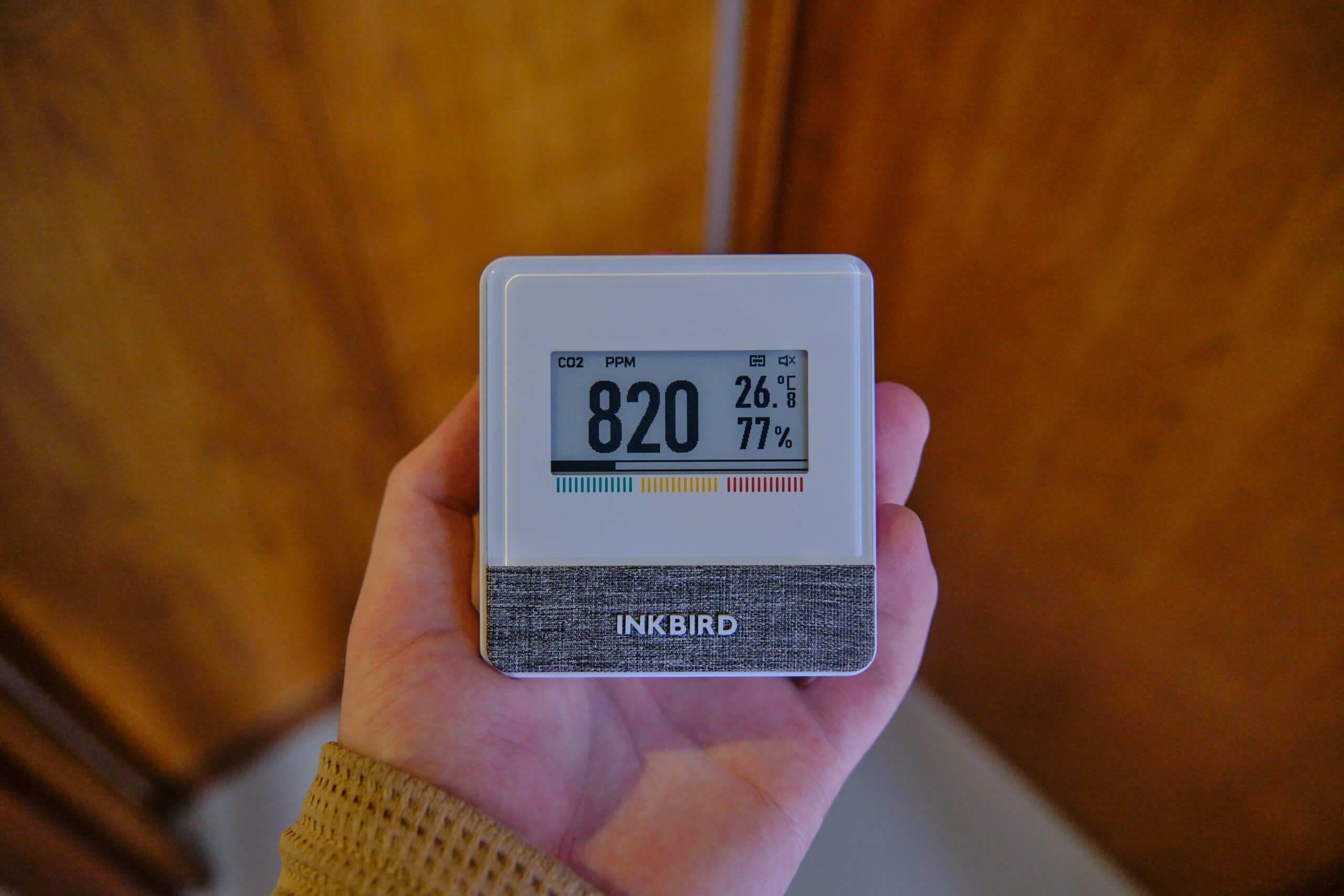
One of the headline features of the INKBIRD IAM-T1 is the four-year battery life (if you set readings to once per ten minutes). Realistically, however, you will only experience this battery life if you use the IAM-T1 as a desk-based monitor, as 10-minute readings are useless on the go.
More realistically, you’ll set the monitor to take a reading every minute or every two minutes via the app. Both of these intervals are far more useful and will allow you to see the latest CO₂ concentration changes as they happen. While I haven’t had the monitor long enough to test the battery life at these settings, some basic maths shows we should have about five months of battery life at one-minute intervals and ten months with two-minute intervals.
With such a long battery life, I’ve never found myself worrying about the IAM-T1 in the way I would the Vitalight Mini CO₂ Detector or CO₂.Click Model C, which both have only a day of battery life or a few days if you use them conservatively. I appreciate this extensive battery life, and it’s relieving not to have yet another device I need to remember to charge daily.
If you want to extend the battery life and don’t mind losing some connectivity, you can turn off Bluetooth on the device and rely on the display alone. I don’t see this need, though, as the battery life is already exceptional and rivals that of the Aranet4.
Equally as crucial for portability is the size and shape of the device. Luckily, the INKBIRD IAM-T1 is equally as strong in both aspects as it is a relatively compact device with an easily baggable shape and good build quality.
When I first saw images of the device, I assumed it would be a similar size to the Aranet4 Home. Once I held the product, I quickly realised this wasn’t the case as the IAM-T1 is slightly bigger in all dimensions and heavier. While I didn’t find this an issue, as it’s still relatively compact, it’s important to note that the device isn’t exactly small.
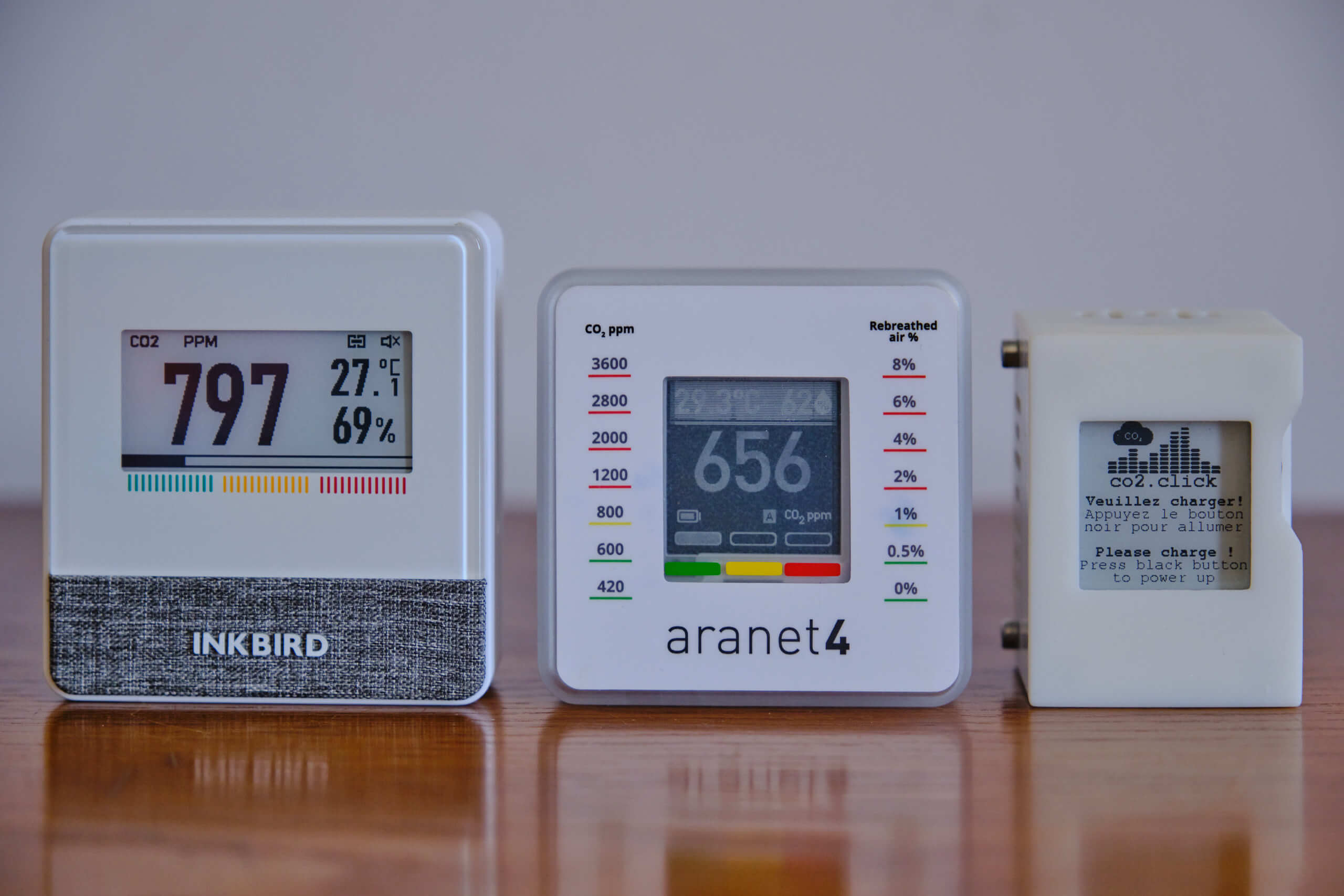
My Aranet4 is unfortunately broken, so the screen doesn’t accurately represent what it usually looks like.
Would I call the IAM-T1 pocketable? Probably not. Sure, it will fit in many pockets, but you may have issues fitting the device in if you wear pants with smaller pockets. Furthermore, the weight of the IAM-T1 means I often found my pants or shorts slowly falling down when combined with my phone, wallet, and headphones (which I usually carry in my pockets).
On the other hand, the device is easily baggable and is easy to slide into a backpack, handbag, or even a satchel. With the great connectivity of the device, this is a good solution as you can quickly check the carbon dioxide concentration without ever removing the device from your bag.
I would like to see some karabiner or wrist-loop slot, but this is a minor complaint, and since many users will use the IAM-T1 as a desk or wall-mounted monitor, I can understand the choice not to include such a slot.
The INKBIRD IAM-T1 feels well-built, and the materials all feel high quality. Overall, I would say this is the best-constructed carbon dioxide monitor I’ve used to date. It has a substantial weight that makes it feel solid, and I am confident placing this device in my bag or my girlfriend’s handbag whenever we go out. I know I don’t need to worry about it getting damaged.
However, one factor to remember is that, like all carbon dioxide monitors, the IAM-T1 is not waterproof or even resistant. In fact, it’s quite the opposite. To allow air inside the monitor, it has large vents on the sides, meaning that it should not be stored in a bag with liquids inside.
In conclusion, the IAM-T1 is portable but not exceptionally so. It’s a device you can easily place in your bag, but you may struggle to fit it inside your pockets. Thankfully, the built quality is excellent, and you know the device will survive in your backpack or handbag. Battery life is fantastic, and you won’t need to worry about running out of juice in day-to-day use.
Purchase IAM-T1 from Amazon | INKBIRD
Connectivity & Application
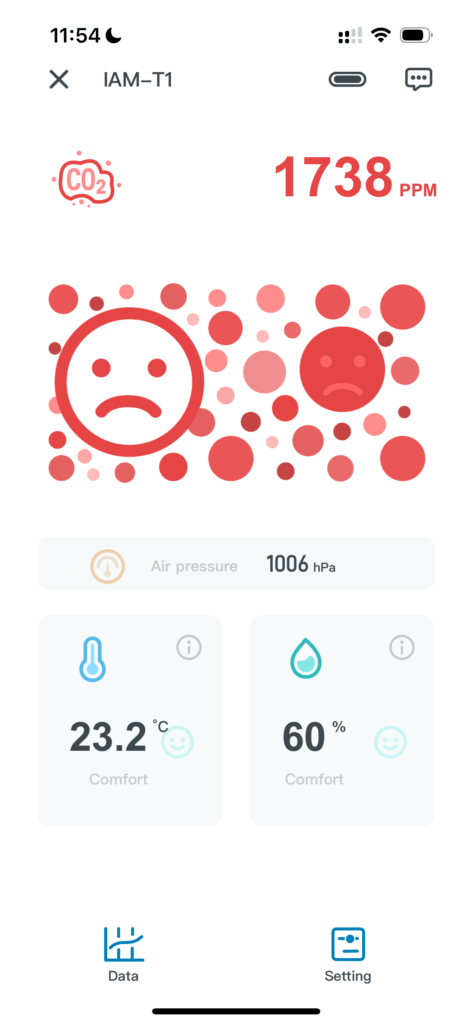
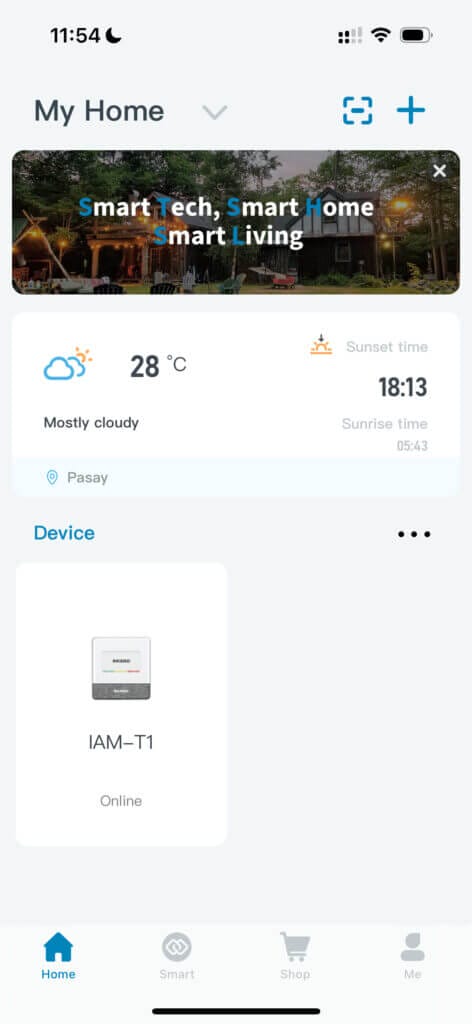
Left: IAM-T1 home screen. Right: App home screen.
The INKBIRD IAM-T1 has Bluetooth 5.0, a recent version of Bluetooth designed to allow for better connections and lower power draw. It’s fantastic to see a recent version of Bluetooth used in the IAM-T1, and it likely leads to battery-life benefits, too.
If you choose to use Bluetooth (you can disable it and use the monitor as a standalone device if you so decide), you can enable this via a switch under the battery cover on the back of the device. Once enabled, you must download the INKBIRD app on the App Store or Play Store. If you can’t find the app, an ‘APP Quick Start Guide’ is included in the box. You can find a QR code on this sheet that will take you straight to the applicable store.
The free app requires iOS 12.0 or Android 7.1 or above to download. You will need to make an account to use the app, and while I’m not a fan of this, I understand the need as INKBIRD has a whole connected ecosystem, and the app is intended to be used with many monitors connected.
As I use an iPhone, I could sign in with my Apple ID, which hides my email address to prevent my email from being leaked in the event of a hack or otherwise. If you don’t have an Apple ID, you can also use a Google account or make an account on the app itself.
Once you’re logged in, you will be prompted to add your first device. This process was painless, and the app instantly detected my IAM-T1 – within seconds, it was connected, and there were no hitches. This is one of the most seamless setup experiences I’ve experienced from an air quality monitor.

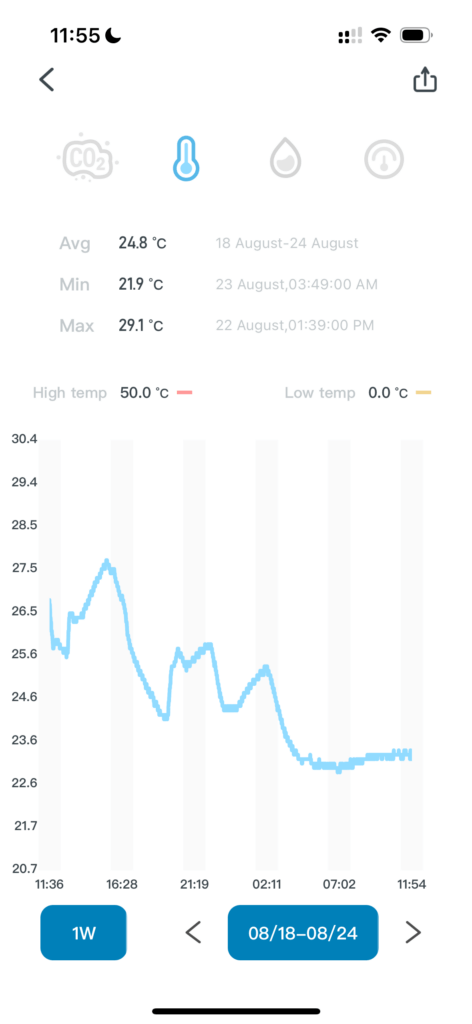
Data logging on the IAM-T1.
After adding a device, you will be taken to the app’s home screen. You can view your home, create smart automations, purchase INKBIRD products, and edit your account settings from here. While it’s outside this article’s scope, the INKBIRD app allows for tons of customisation if you have multiple of its products. Having automations and allowing users to manage multiple homes from within one app is extremely useful!
However, we’re focusing on the IAM-T1, so let’s look at that part of the app. When you tap on your carbon dioxide monitor from the home screen, you’ll be taken to an overview screen showing the carbon dioxide concentration, air pressure, temperature, and humidity. You will also have the option to edit device settings and view historical data.
The historical data view allows you to view measurements from all four sensors throughout the day, week, month, quarterly, six-monthly and year. This means the device’s data is stored within the app for at least one year – much longer than most competing monitors and a significant advantage if you like digging into data.
On this note, it’s important to remember that data is stored locally on the monitor for only 30 days. Therefore, if you want to keep all of your data, you must ensure you connect the device via Bluetooth to your phone at least once per month.
While the app is great for looking at recent trends, you’ll want to export data for in-depth analysis. Thankfully, INKBIRD hasn’t overlooked this feature and exporting data is possible from within the app. Data will be exported as a text document, which can be shared (at least on iPhone) via a messaging app or email. You can also save the data to your device if you choose.
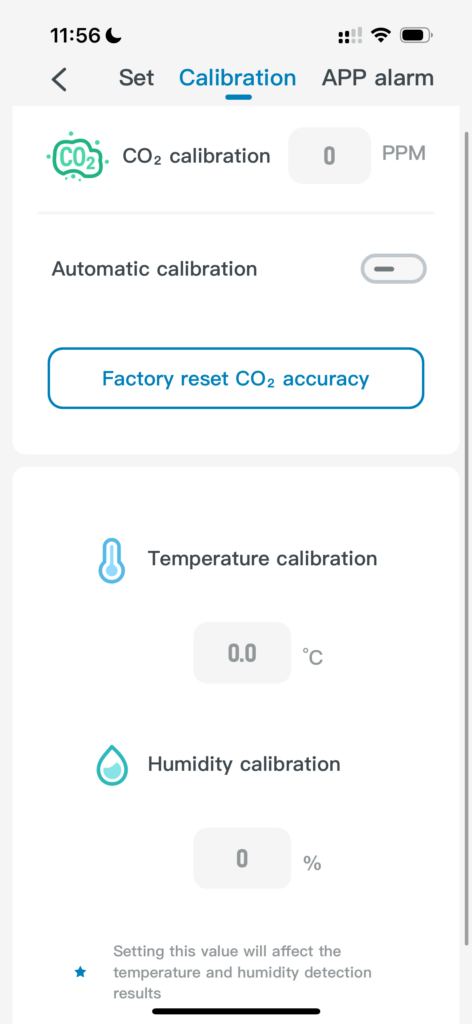
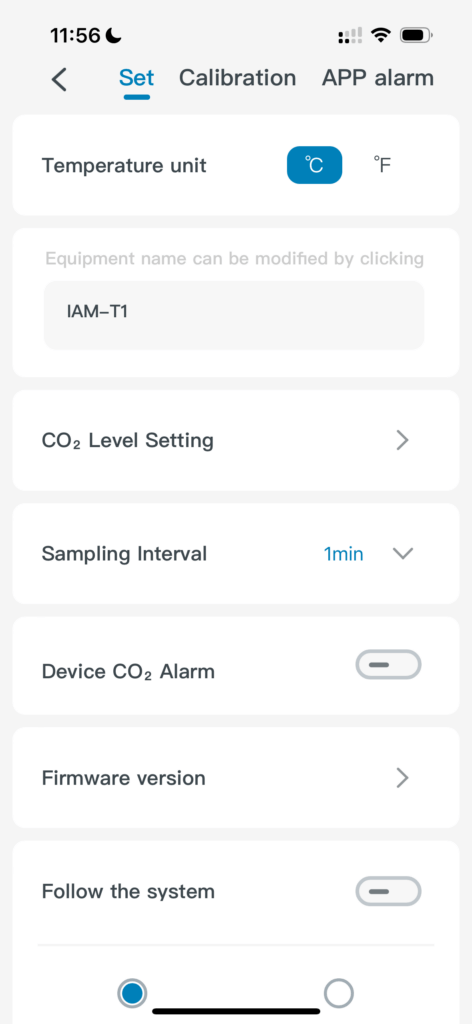
Left: IAM-T1 calibration settings. Right: IAM-T1 settings.
The INKBIRD app also allows the user to calibrate all of the sensors on the device except for the atmospheric pressure setting. I appreciate this feature, and it’s also great to see that the user can toggle auto-calibration depending on their needs. In my case, I leave it disabled.
Finally, there is a settings menu within the app. From this settings menu, you can change the temperature unit, CO₂ levels (which will adjust the bar on the device’s screen), sampling interval, the alarm settings (both whether it’s enabled or disabled and how often it will alert the user), and update the firmware version. The settings menu is simple, but I can’t think of any obvious settings that have been overlooked.
All-in-all, the connectivity of the IAM-T1 and the INKBIRD app have been pleasant to use. The device automatically reconnects whenever I am within range of it, and the app is fluid and easy to use. It’s a very smooth app, and you can tell that INKBIRD has experience in this area because it’s worked flawlessly for me so far.
Purchase IAM-T1 from Amazon | INKBIRD
Pricing & Competition
So far, I’ve spoken positively about the INKBIRD IAM-T1 and its feature set. However, none of this is important if the price isn’t right. With that in mind, I want to compare the price of this carbon dioxide monitor to other popular monitors on the market and see if the price adds or removes from its overall appeal.
Below, I’ve created a table showing the pricing of different carbon dioxide monitors at their standard price. Please keep in mind that prices can fluctuate and sales can happen. Therefore, these prices aren’t fixed, and you can likely find each device cheaper.
The IAM-T1 has a standard price of $169, making it $80 cheaper than its most direct competition, the Aranet4 Home. I’ve also been told that regular sales are expected, and you may be able to find the IAM-T1 with as much as 40% off. With this discount, the device is extremely tempting.
| CO₂ Monitor | Price |
|---|---|
| INKBIRD IAM-T1 | $169 |
| CO₂.Click Model C | (approx) $150 |
| CO₂.Click Model D | (approx) $140 |
| Aranet4 Home | $250 |
| Aranet4 Pro | $290 |
| Qingping Air Monitor Lite | $90 |
| Qingping Air Monitor | $130 |
| Forensics Detectors CO₂ Monitor | $100 |
Even at full price, the INKBIRD IAM-T1 offers a feature set similar to the Aranet4, making it a tempting offer. While it’s still an expensive product, the pricing is competitive. However, at the full price of $169, it competes with CO₂.Click monitors. These monitors have very different target audiences, though, as the CO₂.Click Model C and Model D are not intended to be portable like the IAM-T1.
My conclusion is this: if you can get a discount on the Aranet4 Home and find it at a similar price, opt for that instead. However, at the regular prices of $169 and $250, I would go for the INKBIRD product instead – unless you need the smaller size or less drift-prone sensor of the Aranet4. With a discount such as the 40% launch discount on the INKBIRD product, it’s no longer a question – unless you need one of the few Aranet features that aren’t on offer here, the IAM-T1 is a steal at around $100.
Purchase IAM-T1 from Amazon | INKBIRD
Conclusion

I’ve found it hard to fault the INKBIRD IAM-T1 because it’s such a solid carbon dioxide monitor. At $169, it’s still a pricey option, and you can find much cheaper alternatives as low as $50. However, before this review, no monitor came close in features and functionality to the much more expensive Aranet4 Home.
I have now changed my mind. For almost $100 less (and more when the device is on sale!), the IAM-T1 is a complete carbon dioxide monitor that features nearly everything the Aranet does but at a much lower price. While the Aranet4 has a few nice features the INKBIRD product lacks (such as on-demand readings), these features are relatively minor, and there’s nothing to say that INKBIRD won’t add them in the future as the IAM-T1 can receive over-the-air updates.
The device isn’t perfect, but it’s well-rounded. Would I like to see the ability to manually calibrate the device without using the app? Yes. Would I like to see an auto-calibration/manual calibration switch on the device? Yes. However, these are minor issues that can be toggled within the app. This leads me to conclude that the INKBIRD IAM-T1 is as functional as the Aranet4 Home as a connected monitor but has some slight disadvantages if you plan to use the device standalone.
The only significant disadvantage I see when comparing these two devices is the larger size of the IAM-T1. Even this is minor, though, as I found the product easy to store in my backpack when I went out. Since connectivity is excellent, it’s super easy to check the app whenever you want to get an update on the carbon dioxide concentration.
The IAM-T1 also has a more drift-prone sensor than the Aranet4, but this should be an issue with regular calibrations. Unless you have a specific use, the less drift-prone sensor and smaller size of the Aranet are hard to justify when the price also jumps by $80.
On the other hand, some features even make the IAM-T1 more appealing than the competition. For example, the ability to adjust the green, yellow, and red CO₂ concentration thresholds on the device’s ‘loading bar’ is convenient and makes the device so much easier to introduce to someone. While the Aranet has a similar feature, the bar is, in my opinion, a much better implementation.
Of course, the INKBIRD product also has all the basics covered. It’s accurate, has good connectivity and has excellent battery life. If you’re in the market for a new carbon dioxide monitor with all the features you might want, the INKBIRD IAM-T1 is worth looking at.
Again, I would like to mention that this review is not sponsored. I received an IAM-T1 from INKBIRD with the promise I would review it. However, I made it clear to INKBIRD that I would share my honest opinions after using the device for a few weeks. I have access to a wide range of CO₂ monitors, and the IAM-T1 is now my daily device. While I still opt to use the Aranet4 and CO₂.Click Model C in some circumstances, I have been very happy with the IAM-T1.
Purchase IAM-T1 from Amazon | INKBIRD
Is the INKBIRD IAM-T1 Accurate?
Yes. Both from my findings and based on the Senseair sensor used, the INKBIRD IAM-T1 can accurately measure the carbon dioxide concentration.
What Alternatives Are There to the IAM-T1?
The Aranet4 is the closest alternative and shares many of the same strengths. The Vitalight Mini CO₂ Detector is a cheaper alternative but lacks many features.
What Does the IAM-T1 Measure?
The monitor measures carbon dioxide concentration, temperature, relative humidity, and atmospheric pressure.
Does the IAMT1 Have Connectivity?
Yes. The IAM-T1 has Bluetooth 5.0 for connecting to any modern smartphone.
Have Questions or Comments?
Join the discussion on the BreatheSafeAir Community Forum. Ask any questions you have about air quality or adjacent topics and get quick answers!
INKBIRD IAM-T1
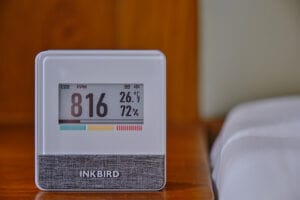
The INKBIRD IAM-T1 is a new carbon dioxide monitor that shares many of the features of the Aranet4 Home but at a much lower price. However, is it worth it?
Product Brand: Inkbird
4.5
Pros
- Accurate NDIR sensor
- Includes temperature, relative humidity, and atmospheric pressure sensors
- Relatively compact size
- Very long battery life
- Good build quality
- More affordable than the Aranet4
- Responsive app with customisable features
- Regular sales
Cons
- Slightly larger than I would like
- More pricey than some alternatives
- Sensor is more prone to drift than the Aranet4
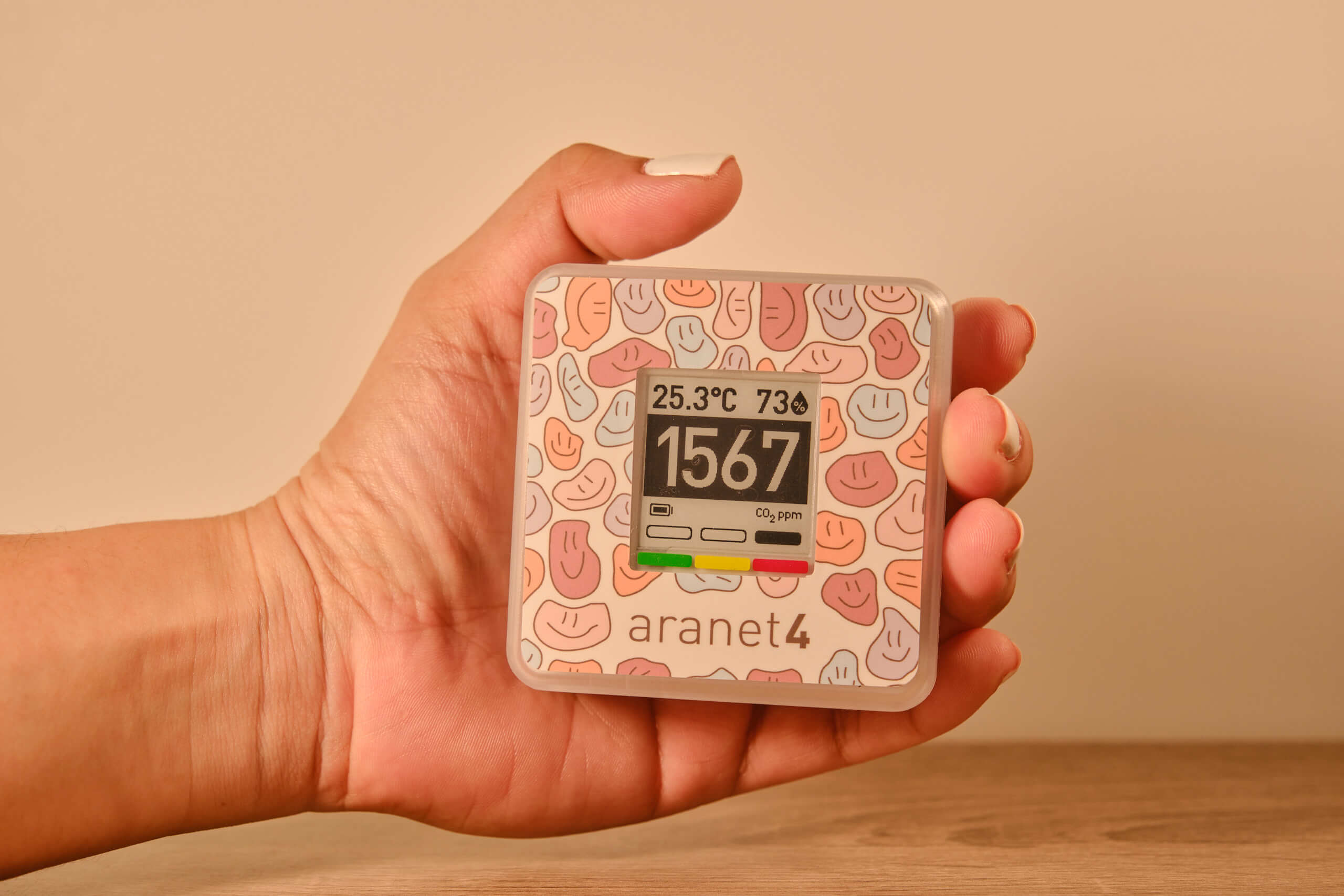

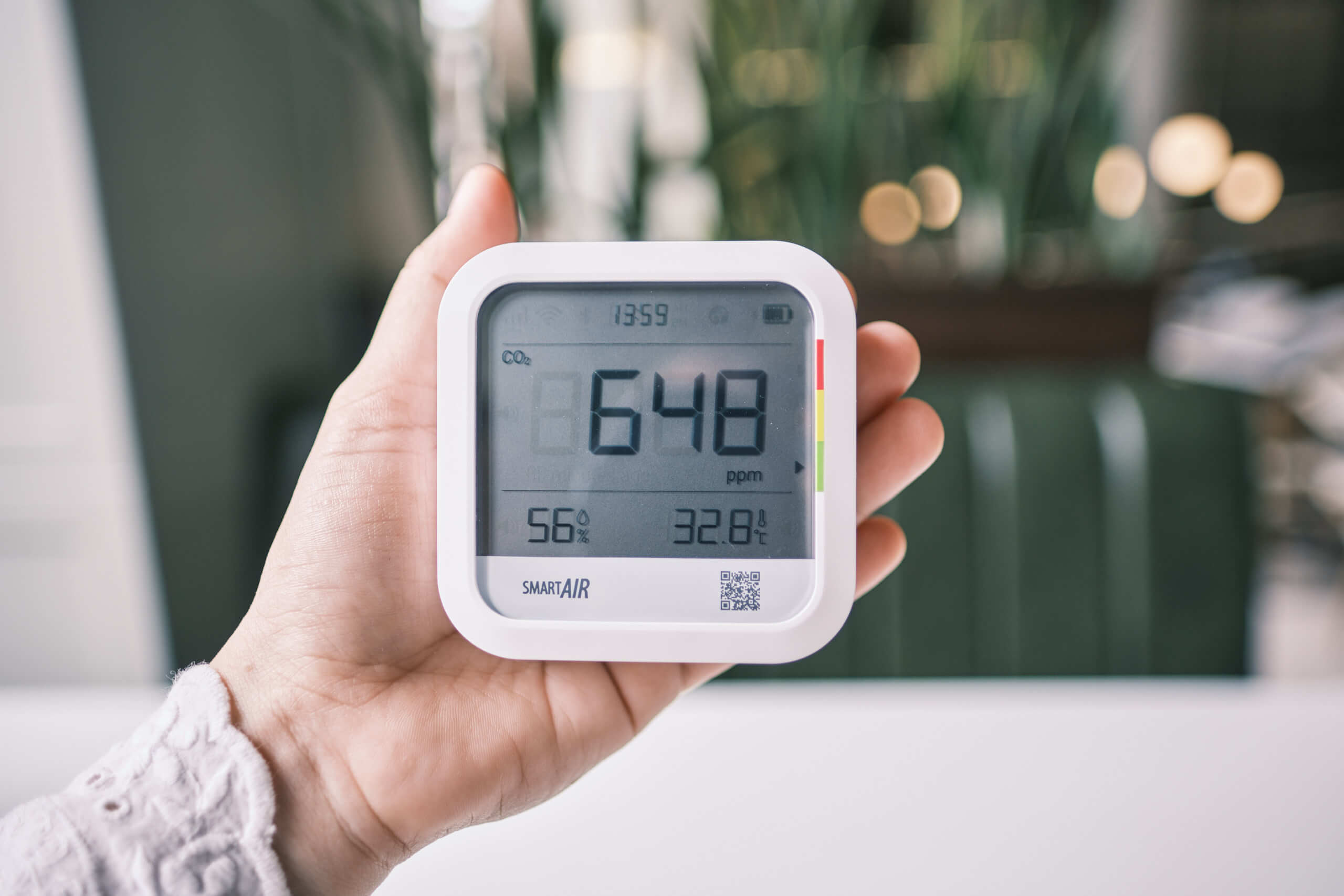
Aranet4 HOME has regular good promos too (discounts offered on Amazon and Aranet official e-shop).
+ recently they also offer free shipping. Thanks for the revue! I am not dissapointed with Aranet! 🙂
I have one of these and I can’t for the life of me find a manual calibration option in the app. Your screenshots look like mine, but there’s no button or anything else for “manual calibration.” I tried the “Factory reset CO2 accuracy” button, and it just said “Saved” in response. (Is that it? If so, that’s not clear at all.)
The only thing I can find from Inkbird is this page: https://community.inkbird.com/t/iam-t1-calibration/99738 Their instructions for automatic calibration are completely impractical for most people, so that’s not an option.
Help?
Hi Nancy,
Yes, the ‘factory reset CO2 accuracy’ button will recalibrate the device. I told INKBIRD this should be renamed for clarification, but it looks like they never acted and actually changed the text.
If you place the device outside, walk a few metres away, and then press ‘factory reset CO2 accuracy’, it will recalibrate. From memory, the process is quite fast but I would leave the monitor alone for a few minutes to be sure.